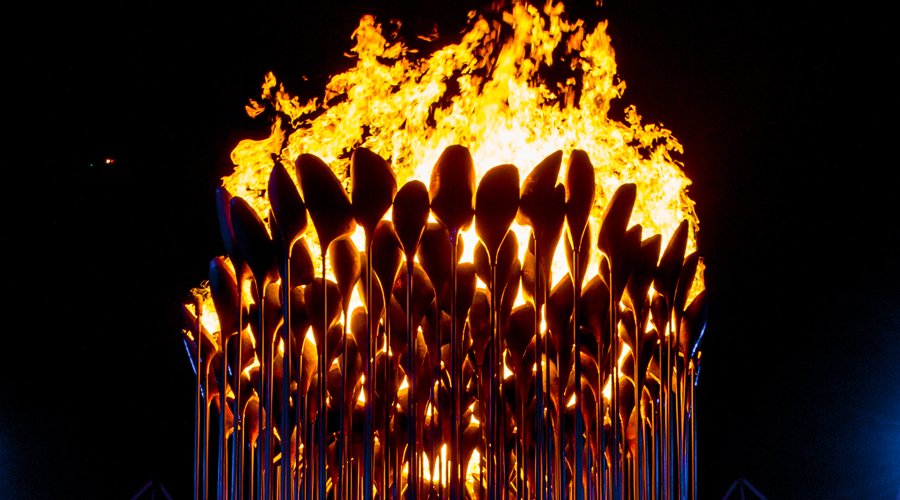
Heatherwick 2012 Olympic Cauldron
14 January 2013
by Nicolas Jackson
Like quite a few people, I’m sure, I found myself surprisingly transfixed by last summer’s Olympic Games and unexpectedly empty and nostalgic once they were over. Perhaps that explains why, two months on, finding myself in a hotel lobby in the medieval town of Segovia (Spain) waiting to meet designer and architect Thomas Heatherwick, it felt almost as if a slice of the Games was about to arrive. Such is the power of television and the impact of the Olympics, that it seemed as if the man responsible for the famous Cauldron which bore the Olympic flame exuded “Games dust” in the same way that Tinkerbell gives off fairy dust. When Thomas Heatherwick came through the door it was as though the combined weight of some 90,000 people who witnessed the spectacular lighting of the Cauldron from inside the stadium, and the further 900 million who watched on TV, cast a giant’s shadow from a man about the same age and build as me.
I was to interview Thomas Heatherwick for a radio programme I present on the Spanish national broadcaster, Radio Nacional de España.* Reading his biography, you could be forgiven for thinking that all that Thomas Heatherwick touches turns to gold. The UK’s award-winning Seed Cathedral pavilion at the 2010 Shangai Expo (smaller budget, biggest impact - and which of Heatherwick Studio’s projects haven’t been won awards?); the emblematic new London double decker buses; the Cauldron itself – all these massively visible projects give the impression of infallibility and of a linear path to success. But as Heatherwick was at pains to point out, the renown he enjoys today is based on years and years of toil, risk-taking and perseverance since he set up Heatherwick Studios in 1994. It’s like watching one of those biopics at the cinema where you know through hindsight that the subject is destined to triumph but it probably didn’t quite look so obvious at the time.
Thomas Heatherwick had travelled to Spain to give a talk as part of the Hay Festival Segovia, the 7th edition of the Spanish version of the annual literary and cultural festival from Hay-on-Wye, Wales - Bill Clinton’s “Woodstock of the mind”. Heatherwick was a guest of IE School of Architecture, one of the most prestigious schools of its kind in Spain, which counts Martha Thorne, director of the Pritzker Prize for Architecture, amongst its staff. IE had very kindly squeezed in this interview with me about an hour before the public talk Thomas Heatherwick had come to give. I’m not sure whether it’s because Heatherwick is a slow and considered speaker, or whether it was because our interview turned into quite an extended chat, but the assurances I’d given to the organisers that 15-20 minutes would be plenty of time started to look a little hasty. IE’s PR director began to shoot me concerned looks once we went beyond the half hour point. I did my best to ignore them. This became impossible when 10 minutes before Heatherwick was due on stage 10 minutes away we still hadn’t quite wrapped up the last question. No matter, coats on (it starts getting cold in Segovia in late September), umbrellas up (and it rains too), I trotted alongside Thomas Heatherwick through the narrow, cobbled streets and alleys with a microphone shoved in his face to get that last answer to that last question. Still jogging we said goodbye at the door of the venue and Heatherwick trotted in and onto the stage for the main gig - another hour of public exposure for someone who gives every impression of being a very private man.
There’s no need to talk here of the content of that interview with Heatherwick – you’ll just have to listen to the programme, won’t you? (see link) – but there are a few things that stood out for me and which I’ve thought about often since. One of them is how it felt to know the world is watching your Olympic cauldron being lit and your there hoping it will actually work and that they’ll like it, in a stadium of 90,000 with your mother sitting next to you. Another is the analogy of the sat nav and what it teaches us about problem solving and overcoming setbacks. (Like I say, you’ll just have to listen to the programme to know what that’s about!) The last one is the memory Heatherwick has of his degree show when so many of his peers were hoping they would be “discovered” and launched to fame and success. Thomas Heatherwick has never waited to be discovered, he’s just done the things he’s felt driven to do and it turns out that those things have won applause the world over. I’m sure it’s that, more than “Games dust”, which really accounts for the size of his shadow.
Nicolas Jackson's interview with Thomas Heatherwick is available here
*The radio programme North by Southwest is produced by the British Council in collaboration with Spanish national broadcaster Radio Nacional de España (RNE). It recently celebrated three years of broadcasts across the English speaking world where it reaches a fortnightly audience of 2 million listeners. The programme features interviews with artists and cultural figures and experts from the UK as well as cultural relations between the UK and Spain. The list of participants in the programme is too large to enumerate but includes cultural figures like, A.S. Byatt, Terence Davies, Jonathan Coe, Portico Quartet, Sue Hoyle, Colin Tweedy, Posy Simmonds, David Hare, Lloyd Newson, London Sinfonietta, former Secretary of State for Culture Ben Bradshaw, Cherie Blair, Deborah Warner, Gilbert & George, Vernon Ellis, Martin Davidson and Sir Nicholas Serota, to mention but a few. Previous editions of the programme can be listened to here
Category
Commentary
Tags